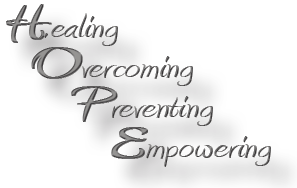


|
* Common myths * Who is a victim ? * Cycle of violence *
Domestic Violence
Domestic violence and emotional abuse are behaviors used by one person in a relationship to control the other. Partners may be married or not married; heterosexual, gay, or lesbian; living together, separated or dating.
Examples of abuse include:
Violence can be criminal and includes physical assault (hitting, pushing, shoving, etc.), sexual abuse (unwanted or forced sexual activity), and stalking. Although emotional, psychological and financial abuse are not criminal behaviors, they are forms of abuse and can lead to criminal violence.
The violence takes many forms and can happen all the time or once in a while. An important step to help yourself or someone you know in preventing or stopping violence is recognizing the warning signs listed on the "Violence Wheel".
ANYONE CAN BE A VICTIM! Victims can be of any age, sex, race, culture, religion, education, employment or marital status. Although both men and women can be abused, most victims are women. Children in homes where there is domestic violence are more likely to be abused and/or neglected. Most children in these homes know about the violence. Even if a child is not physically harmed, they may have emotional and behavior problems.
If you are being abused, REMEMBER:
COMMON MYTHS AND WHY THEY ARE WRONG
Domestic violence is not a problem in my community.
Domestic violence only happens to poor women and women of color.
Some people deserve to be hit.
Alcohol, drug abuse, stress, and mental illness cause domestic violence.
Domestic violence is a personal problem between a husband and a wife.
If it were that bad, she would just leave.
MANY VICTIMS DO LEAVE AND LEAD SUCCESSFUL, VIOLENCE FREE LIVES.
ANYONE CAN BE A VICTIM! Victims can be of any age, sex, race, culture, religion, education, employment or marital status. Although both men and women can be abused, most victims are women. Children in homes where there is domestic violence are more likely to be abused and/or neglected. Most children in these homes know about the violence. Even if a child is not physically harmed, they may have emotional and behavior problems.
If you are a person of color ...
If you are a lesbian, gay, or transgendered person ...
If you are physically or mentally challenged or elderly ...
If you are a male victim of abuse ...
If you are from another country ...
If your religion makes it hard to get help ...
If you are a teen ...
It is hard for teens to leave their abuser if they go to the same school. They cannot hide. Gay and lesbian teens are very isolated. They can be scared they may have to reveal their sexual orientation.
If you think you are being abused, think about getting help. If your family or friends warn you about the person you are dating, think about getting help. Tell friends, family members or anybody you can trust. Call a resource listed in this book. There is help for you. You do not have to suffer in silence.
If you are a child in a violent home ...
Violence in the home is dangerous for children. Children live with scary noises, yelling and hitting. They are afraid for their parents and themselves. Children feel bad that they cannot stop the abuse. If they try to stop the fight, they can be hurt. They can also be hurt by things that are thrown or weapons that are used. Children are harmed just by seeing and hearing the violence.
Children in violent homes may not get the care they need. A parent who is being abused may be in too much pain to take good care of their child. Children who live in violent homes can have many problems. They can have trouble sleeping. They can have trouble in school and getting along with others. They often feel sad and scared all the time. They may grow up feeling bad about themselves. These problems do not go away on their own. They can be there even as the child gets older.
There is help for children in violent homes. Call a resource listed in this book to talk to someone. This can also help if you grew up in a violent home.
If you are being stalked ...
People may think stalking is not dangerous because no one has been physically hurt. Stalking is serious. It is against the law. It often turns to physical violence.
There is help. Find out how to get a Personal Protection Order (PPO). You can also tell the police. You can make a case by keeping track of what the stalker does by:
STALKING IS A CRIME.
What is Abuse? - A Warning List
Many people who are being abused do not see themselves as victims. Also, abusers do not see themselves as being abusive. People often think of domestic violence as physical violence, such as hitting. However, domestic violence takes other forms, such as psychological, emotional, or sexual abuse.
Domestic violence is about one person in a relationship using a pattern of behaviors to control the other person. It can happen to people who are married or not married; heterosexual, gay, or lesbian; living together, separated, or dating.
If your partner repeatedly uses one or more of the following to control you:
YOU HAVE BEEN ABUSED!!
Remember threatened or actual physical violence may be illegal. Consider calling the police for help.
This chart uses the wheel to show the relationship of physical abuse to other forms of abuse. Each part shows a way to control or gain power.
Incident
Tension Building
Making-Up
Calm
The cycle can happen hundreds of times in an abusive relationship. Each stage lasts a different amount of time in a relationship. The total cycle can take anywhere from a few hours to a year or more to complete.
It is important to remember that not all domestic violence relationships fit the cycle. Often, as time goes on, the 'making-up' and 'calm' stages disappear.
Adapted from the original concept of: Walker, Lenore. The Battered Woman. New York: Harper and Row, 1979 | ||||
|
|



